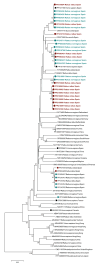National survey of the rat hepatitis E virus in rodents in Spain, 2022 to 2023
- PMID: 40156345
- PMCID: PMC11951417
- DOI: 10.2807/1560-7917.ES.2025.30.12.2400473
National survey of the rat hepatitis E virus in rodents in Spain, 2022 to 2023
Abstract
BackgroundRat hepatitis E virus (ratHEV) is an emerging virus causing acute and chronic hepatitis in humans. Rats are the main natural reservoir of this pathogen. Large-scale studies assessing ratHEV circulation in rodents in Spain are lacking.AimWe aimed to determine the prevalence of ratHEV in rats in Spain and evaluate potential transmission risk to humans.MethodsWe designed a cross-sectional nationwide study where black (Rattus rattus) and Norway (R. norvegicus) rats were collected and analysed between 2022 and 2023 for ratHEV infection using real-time (RT)-qPCR testing of liver tissue. Sequencing and analysis of ratHEV shedding in faeces were carried out in positive animals.ResultsRatHEV was detected in 125 of the 481 rats analysed, supposing a prevalence of 26.0% (95 CI%: 22.3-30.1). Positive rats were found in urban (25.6%), and farm (29.8%) settings. Black rats (31.3%) had 1.5 times higher odds of being infected by the virus than Norway rats (22.5%) (p = 0.049). Significantly higher prevalence of ratHEV was detected in rodents sampled from southern (31.9%) than northern (17.8%) Spain (p = 0.003). Viral RNA was detected in faeces from 45.5% of infected rats. Phylogenetic analysis evidenced a wide genetic diversity of ratHEV sequences, some showing high homology with ratHEV strains found in patients from Spain.ConclusionsCirculation of ratHEV appears to be heterogeneous and the virus appears to be endemic among rat populations in Spain, highlighting the possible risk of zoonotic transmission of this emerging virus in this country.
Keywords: emerging; public health; rat hepatitis E virus; rats; rocahepevirus; zoonoses.
Conflict of interest statement
Figures
References
MeSH terms
Substances
LinkOut - more resources
Full Text Sources


